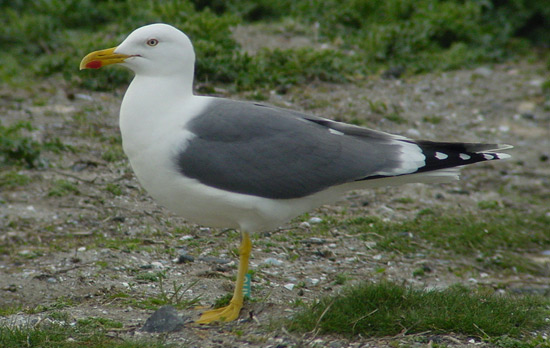 03 May 2003
03 May 2003| LBBG 12cyAH6, May
03 2003, Voorhaven, Zeebrugge, Belgium (51.21N,
03.11E).
AH6, born in the colony Maasvlakte, the Netherlands (51.59N, 04.02E). AH6 was ringed as pullus on July 20 1992, now in 12cy and believed to be a hybrid Yellow-legged Gull (michahellis) x Herring Gull (argenteus). 2002 and 2003 AH6 was paired with blue BWAD, probably ringed as pullus at Zeebrugge, Belgium, summer 1999. BWAD is a male, aggressive in defending its territory at the colony of Zeebrugge and this individual shows only very little black markings on both upper mandible and the cutting edge of the lower mandible. The iris is clear yellow. This couple nicely demonstrates the migration of LBBG from the Netherlands to the growing colony of Zeebrugge. |
 03 May 2003
03 May 2003
 03 May 2003
03 May 2003
AH6 was rediscovered on two occasions winter 2001-2002 and 2002-2003 in southern France, as the website of Alain Fossé shows:
|
|
place of rediscovery: |
coordinates |
distance |
| 24·12·01 | la Courtrie/Le Louroux-Béconnais | 47.30N, 00.54W | 609 km |
|
10·01·03 |
la Petite Guibarderie/La Chapelle-Hullin |
47.45N, 01.05W |
596 km |
Alain questions if it is a "Goéland argenté
x Goéland leucophée", a hybrid Larus argentatus x Larus michahellis? In
his opinion, the mantle colour is darker than
nearby YLG in southern France, as if there is a fuscus influence. But according
to the ringer, Norman Van Swelm, the mother has been a michahellis YLG
and was as dark as the birds of the West Iberian population. AH6 was identified
on its breeding ground as a Yellow-legged Gull Larus michahellis!
This doesn't match the current idea at the colony of Zeebrugge, where AH6
proofed to be much darker than michahellis, reminiscent of graellsii
from western populations in the U.K. It's interesting to see if it really has
been a male Herring Gull in stead of a male Lesser Black-backed Gull, who is the
father.
AH6 was caught by Gérard Séjourné and released on 24th December 2001 on the
rubbish dump of Le Louroux-Béconnais (Maine-et-Loire, France);
it was entangled in plastic bags and exhausted. Alain continues: it has nested,
in at least 2001 at Zeebrugge (Belgium), by then already paired with a male
Lesser Black-backed Gull Larus fuscus, colour-ringed blue BWAD.
 10
January 2003
10
January 2003
On January 10 2003, Alain Fossé and Franck Noël watched the bird at the La Chapelle-Hullin landfill, Maine-et-Loire, France (47.45N, 01.05W), some km's north of the original landfill it was found strangled. They were puzzled by the mantle colour of the bird, which was obvious darker than michahellis and made them think of a 'pale graellsii'. The head was immaculate white as in michahellis and the legs were pinkish-yellow. They wondered if this mantle colour could fit it a hybrid which parents are are both paler, i.e.: can this be a hybrid michahellis x argenteus?
Chris Kehoe (from Tynemouth, U.K.) responded on January 11 2003:Nick Rossiter responded as
well:
An interesting bird. But how do we know who its parents were? If it were ringed
in a colony, surely it is difficult to know the parents of a particular gull. Even
presumed parents may not be the actual parents, unless they are 100% faithful.
So I would say this is a presumed hybrid unless Norman can persuade otherwise.
It's difficult to assess the leg length from the photo but they do look on
the long side for atlantis. The bill is also rather long for atlantis.
The head, bill and orbital ring look fine for michahellis as does the
dull grey tone (grey-blue in atlantis). Even if it has got something else
in it, michahellis looks to be the dominant component in the
structure. How reliable is the mantle shade? The primary tips seem larger
than those normally found in michahellis, even when fresh. Are there any
comments on this from people in the michahellis breeding areas?
Rafael Saiz Elizondo can tell more about the situation in Basque Country: the only autochthonous large gull species was Larus michahellis, but in the last 20 years Larus fuscus graellsii has spread along some colonies. Here, hybridisation is quite common, but Rafael has no description on hybrids.
It indeed is very problematic to pin down the true parents in a colony like the one at Maasvlakte, with numerous possibilities for cross-breeding. There are over 35.000 breeding pairs with at least over ten mixed couples michahellis x argenteus and michahellis x graellsii. Further north, mixed breeding occurs in the colony of IJmuiden (michahellis x graellsii) and further south mixed pairs have been recorded at Neeltje Jans, Zeeland, the Netherlands (michahellis x argenteus) and several mixed pairs have been found recently at Zeebrugge (michahellis x graellsii). Last year, 2002, one pure couple of michahellis managed to raise chicks at Zeebrugge.
Links: